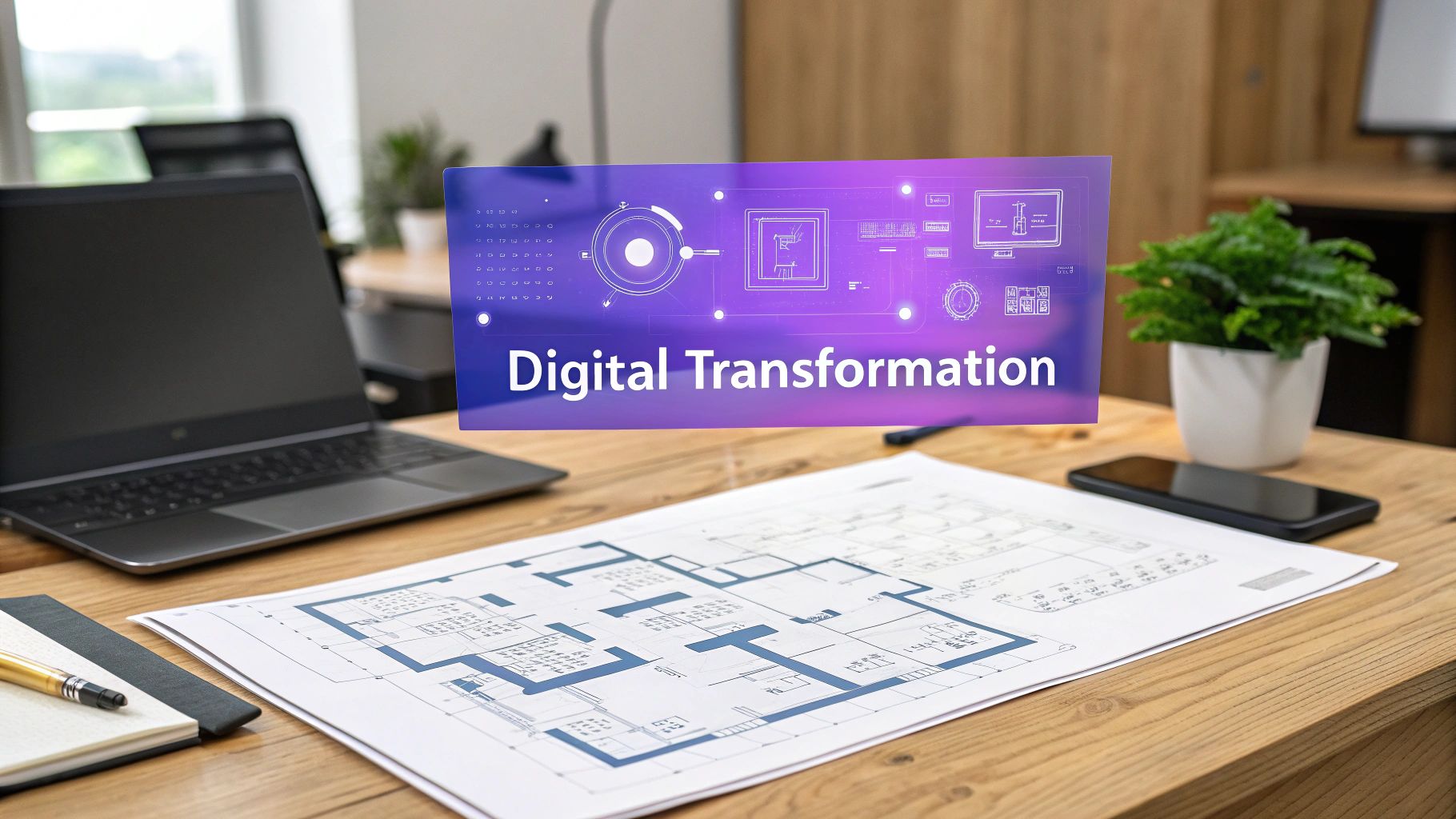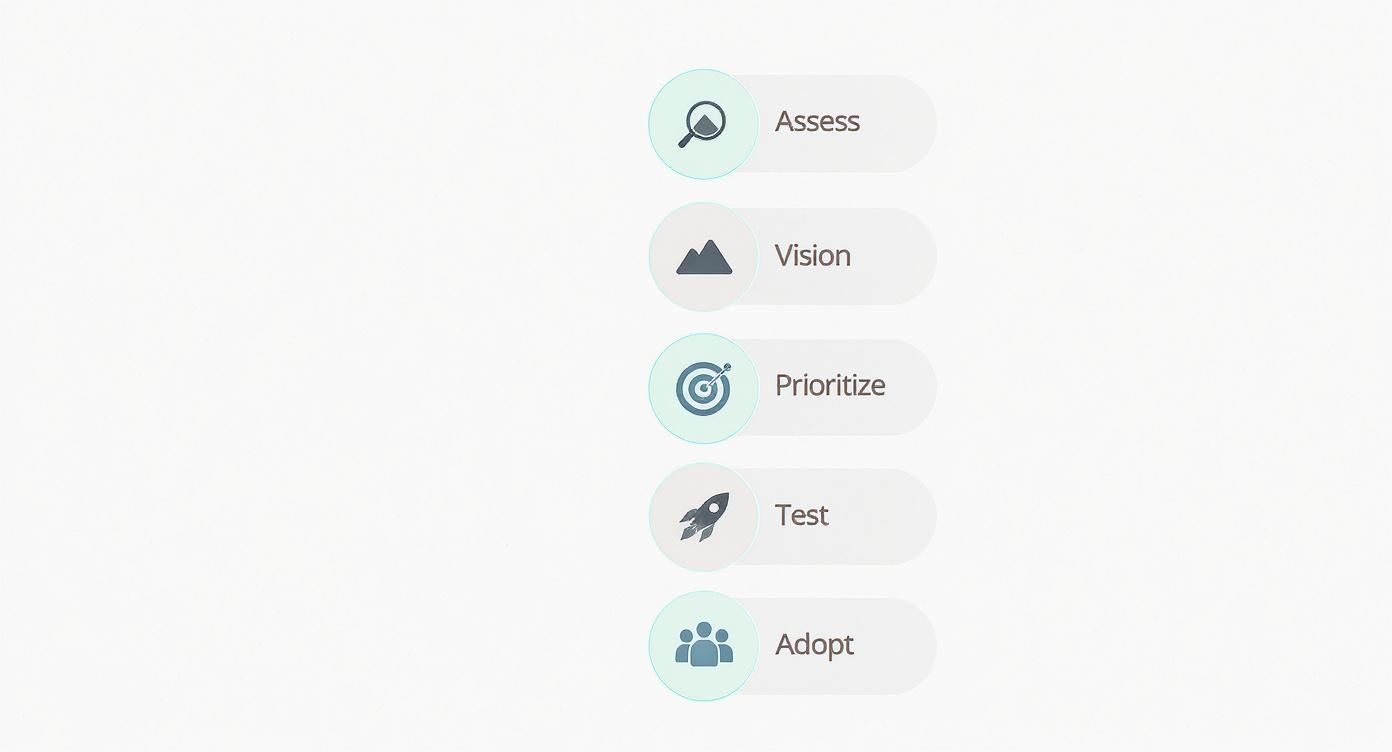Digital Transformation for Businesses a Guide

At its core, digital transformation for businesses is about completely rethinking how you use technology, people, and processes to bring new value to your customers. This isn't just about buying the latest software—it’s a deep cultural and operational shift that weaves digital thinking into every fiber of your company.
What Digital Transformation Really Means

Let's cut through the buzzwords for a second. Think of your business as a classic, well-built house. Over the years, you've added a new appliance here and a gadget there, but the foundation, plumbing, and electrical wiring are decades old.
Digital transformation isn't about just buying a new smart TV (which is like adding a single new tool). It's a full-gut renovation. You're rewiring the entire house, updating all the plumbing, and knocking down walls to create an open, modern living space. It’s all about rebuilding the foundation to meet the demands of today.
Digital transformation is a profound change in how a business operates and delivers value. It challenges the status quo and requires organizations to experiment, become agile, and be comfortable with failure. This is less a tech project and more a business strategy.
This strategic shift touches every single corner of your organization, from back-end operations to the way you interact with customers. To get a better handle on these foundational concepts, you can find more great insights on unlocking growth through digital transformation for small businesses.
Beyond Technology a Shift in Mindset
The most important part of this whole process isn't the technology—it's the culture. A successful transformation requires a "growth mindset," where everyone prioritizes learning and adapting over already knowing it all. It means breaking down rigid silos and encouraging teams to work together across departments.
This cultural evolution is what separates companies that simply use new tools from those that truly transform. It’s the difference between adopting email and fundamentally changing how your teams communicate and share ideas. This change has a direct line to your customer relationships, too; an adaptive and transparent culture is vital if you want to build trust with customers in a crowded market.
Ultimately, this evolution is driven by a few key goals:
- Improving Customer Experience: Using data and digital tools to create seamless, personalized journeys for your clients.
- Achieving Operational Agility: Automating workflows and streamlining processes so you can respond to market changes in a heartbeat.
- Fostering Innovation: Creating an environment where your team feels empowered to experiment and build new solutions.
- Driving Data-Informed Decisions: Moving away from gut feelings and using real analytics to guide your strategic choices.
At the end of the day, digital transformation is about survival and growth. It's the ongoing process of adapting to a world that never stops changing, ensuring your business stays relevant, competitive, and valuable to your customers for years to come.
The Four Pillars of a Successful Transformation

Starting a digital transformation can feel like trying to build a house without a blueprint. It's easy to get lost. To keep things grounded and focused, the whole process is best built on four distinct, interconnected pillars.
Think of them as the load-bearing walls of your business. If one is shaky, the entire structure is at risk. A solid transformation requires a balanced effort across each of these core areas, making sure that your technology, operations, culture, and customer focus are all moving in lockstep.
1 Enhancing The Customer Experience
The first pillar is arguably the most critical because it's directly tied to revenue and loyalty. Enhancing the customer experience isn't just about having a website; it's about using digital tools to understand and serve customers better than ever before. It's about creating seamless, personal, and intuitive interactions at every single touchpoint.
Today's customers expect you to know who they are, what they’ve bought, and what they might need next. Digital tools make this a reality by gathering and analyzing data to create hyper-personalized journeys.
An e-commerce store, for example, can use a customer's browsing history to suggest products they’ll actually want. A B2B software company might use its CRM to track every client interaction, making sure each support call is informed and efficient. The end goal is to make every customer feel like you get them.
2 Achieving Operational Agility
While the first pillar looks outward toward the customer, this one looks inward. Operational agility is all about redesigning your internal processes to be faster, smarter, and more efficient. It means getting rid of the manual, repetitive tasks and clunky old workflows that are holding your business back.
Automation is a huge part of this. When you automate routine jobs like data entry, invoicing, or generating reports, you free up your team to focus on high-value strategic work—the kind of work that actually drives innovation and growth.
Imagine a manufacturing company that puts sensors on its production line. These sensors can predict when a machine needs maintenance, preventing expensive downtime before it ever happens. That shift from putting out fires to proactively managing the business is a perfect example of operational agility. Building strong operational foundations is also a key part of effective strategic planning for small business success.
3 Fostering An Innovative Culture
Here’s the thing: you can have the most advanced technology in the world, but it’s worthless without the right culture to support it. This third pillar is all about building a company-wide mindset that welcomes change, encourages people to try new things, and isn't afraid to fail.
This means breaking down the traditional silos between departments and getting people to collaborate. When your marketing, sales, and product teams are sharing data and insights, they can build much better solutions for your customers, together.
A culture of innovation is built on psychological safety, where employees feel empowered to pitch new ideas and challenge the way things are done without worrying about getting shot down. Leadership has to champion this shift from a "know-it-all" to a "learn-it-all" environment.
This cultural piece is non-negotiable. It’s what allows a business to constantly adapt, turning digital tools into a true competitive edge instead of just another line item on the budget.
4 Integrating The Right Technology
The final pillar is the technology that makes the other three possible. This isn't about chasing every shiny new object. It's about being strategic and investing in tools that directly help you hit your business goals.
The focus should be on creating an integrated tech stack where all your different systems talk to each other. This gets rid of data silos and creates a single, reliable source of truth for the entire company.
A well-planned digital transformation strategy rests on these four pillars. Each one is essential for building a resilient, adaptable, and customer-focused organization. The table below breaks down how each pillar contributes to the bigger picture.
| Pillar | Focus Area | Key Outcome |
|---|---|---|
| Customer Experience | Understanding and serving customer needs | Increased customer loyalty and revenue |
| Operational Agility | Streamlining internal processes | Improved efficiency and productivity |
| Innovative Culture | Encouraging experimentation and collaboration | Continuous improvement and adaptability |
| Technology Integration | Adopting supportive and connected tools | A unified data ecosystem and enabled growth |
Balancing your efforts across these four areas will give you a solid foundation for not just surviving but thriving in the years to come.
The global digital transformation market is projected to explode from $854.6 billion in 2022 to an estimated $4.18 trillion by 2032. This shows it’s no longer a strategic choice but a core business necessity. This incredible growth highlights the urgency for businesses to adopt the right technologies to keep up. You can explore more data on this market expansion and discover more insights about these technology trends on aws.amazon.com.
The Essential Tech That Actually Drives Innovation
Technology is the engine of any modern business evolution, but let's be clear: simply buying the latest software off the shelf isn't a strategy. Real power comes from picking the right tools and weaving them together to solve real-world problems and open up new doors. Getting a handle on which technologies truly matter—and what they actually do—is the first step.
Think of it like a modern toolkit. You wouldn't use a sledgehammer to fix a leaky faucet. In the same way, knowing when to apply Cloud Computing versus AI is what separates a resilient, forward-thinking organization from one that's just playing catch-up.
Cloud Computing: The Foundation for Agility
Before you can build anything cool, you need a solid foundation to build on. In today's business world, that foundation is Cloud Computing. It’s the move away from owning and maintaining clunky physical servers in a back office to essentially renting computing power and storage from giants like Amazon Web Services (AWS) or Microsoft Azure.
This might sound like a simple logistical shift, but its impact is massive. The cloud gives you elasticity—the ability to scale your resources up or down in an instant. If your website gets a sudden flood of traffic after a big announcement, the cloud can automatically handle the load without a crash. This flexibility slashes huge upfront hardware costs and gives you the agility to grow without limits.
The real value of the cloud isn't just about saving a few bucks; it's about speed and access. It lets your teams develop, test, and launch new products and services faster than ever, handing you a serious competitive edge.
The cloud is basically the launchpad for almost every other digital initiative. To put it in perspective, 98.5% of Microsoft’s own internal IT systems now run on its Azure cloud. That tells you just how fundamental this technology has become.
AI and Machine Learning: The Engine for Intelligence
If the cloud is your foundation, then Artificial Intelligence (AI) and Machine Learning (ML) are the intelligent engines you build on top of it. AI isn’t about sci-fi robots taking over; it’s about creating systems that can sift through data, spot patterns, and make smart predictions or decisions with very little human hand-holding.
This capability unlocks some incredible efficiencies and insights. Here are a few ways it’s already working in the real world:
- Predictive Analytics: An e-commerce store can use AI to analyze buying habits and predict which customers are about to leave. This lets the marketing team jump in with a targeted discount to keep them around.
- Process Automation: A finance department can use AI to automatically read invoices, match them to purchase orders, and tee up payments. This kills mind-numbing manual data entry and frees up accountants for more strategic work.
- Personalization: A streaming service like Netflix uses machine learning to analyze what you watch and recommend shows you’ll probably love, creating an experience that feels like it was made just for you.
AI helps a business shift from reacting to problems to getting ahead of them, anticipating what customers need and fixing operational hiccups before they even happen. A recent survey found that 52% of small business leaders expect AI to dramatically streamline their operations. For anyone starting out, it's worth exploring curated lists of digital marketing tools for small business, many of which are now packed with AI features.
The Internet of Things: Connecting the Physical and Digital Worlds
The Internet of Things (IoT) is what pulls the power of digital into the physical world. It’s a network of physical devices—from factory machines and delivery trucks to the thermostat in your office—that are embedded with sensors and software, allowing them to connect and share data over the internet.
This creates a live, digital dashboard of your physical operations. A logistics company can stick IoT sensors on its trucks to track their location, monitor fuel consumption, and optimize delivery routes on the fly. The result? Lower fuel costs and happier customers.
In a factory, IoT sensors on an assembly line can monitor the health of the equipment. By picking up on tiny vibrations or temperature changes, the system can predict a potential breakdown and schedule maintenance before it happens, preventing an expensive shutdown. It's a perfect example of digital tools creating tangible, bottom-line returns.
Data Analytics: Turning Information Into Action
Finally, all these technologies—Cloud, AI, and IoT—are constantly churning out a mountain of data. Data Analytics is the crucial step of digging through that raw information to find trends and get answers. Without it, all the data you’re collecting is just noise.
Good analytics helps you stop relying on gut feelings and start making decisions based on cold, hard evidence. By analyzing sales data, you might discover your most profitable type of customer. By tracking how people use your website, you could find and fix a confusing checkout process that's been quietly costing you sales for months.
This is the glue that holds everything together. It turns the raw output from your tech investments into actionable business strategies that actually drive growth, boost efficiency, and keep customers happy.
How to Build Your Transformation Roadmap
A grand vision is a great starting point, but without a practical plan, it’s just an idea. A successful digital transformation for businesses depends on a clear, actionable roadmap that breaks the entire journey into smaller, manageable steps. This structured approach keeps you focused, builds momentum, and makes sure every effort ties back to real business outcomes.
This visual guide lays out the five essential stages for building a solid transformation roadmap.

Think of this as the journey from your initial assessment all the way to full-scale adoption. Each stage builds on the last, creating a logical path forward that cuts down on risk and maximizes your impact.
1. Assess Your Current Digital Maturity
You can't map out a route without knowing where you are right now. The first step is an honest, thorough look at your company's current digital capabilities. This goes beyond just the tech you use—it's about evaluating your processes, your culture, and your team's skills.
Ask the tough questions: Where are our biggest operational bottlenecks? Are our teams stuck in silos? How well are we actually using data to make decisions? A full assessment gives you a baseline to measure your progress against.
It's also smart to see how you stack up against the competition. A detailed competitor analysis framework can show you where rivals are ahead and highlight opportunities you might be missing. This outside view is crucial for setting realistic but ambitious goals.
2. Define a Clear Vision and Goals
Once you have a clear picture of where you are, it's time to decide where you want to go. Your digital transformation vision shouldn't be a vague statement like "become more digital." It needs to be tied directly to your core business objectives.
Is the main goal to increase customer retention by 20%? Or maybe to slash operational costs by 30% with automation? Your vision has to be specific, measurable, and compelling enough to get the entire organization on board.
A strong vision acts as a North Star, guiding every decision throughout the transformation. It ensures that every new tool adopted and every process changed is a deliberate step toward a defined business outcome, not just change for the sake of change.
This vision provides the "why" that will keep your teams motivated through the inevitable challenges.
3. Prioritize Initiatives for Maximum Impact
You can’t do everything at once. Trying to overhaul every system and process at the same time is a recipe for disaster. The next move is to prioritize your initiatives based on their potential impact and how feasible they are.
A simple but powerful tool for this is an impact/effort matrix. Just plot your potential projects on a chart with "business impact" on one axis and "implementation effort" on the other.
- Quick Wins (High Impact, Low Effort): These are your top priorities. They get the ball rolling and show value early on.
- Major Projects (High Impact, High Effort): These are the big strategic moves that need serious planning and resources.
- Fill-Ins (Low Impact, Low Effort): Tackle these when you have some extra capacity.
- Reconsider (Low Impact, High Effort): These should be avoided or at least put on the back burner.
This method helps you focus your limited resources where they’ll deliver the biggest bang for your buck first.
4. Launch Pilot Programs to Test and Learn
Before you roll out a massive new system across the entire company, it's wise to start small. Pilot programs are basically controlled experiments that let you test new technologies and processes in a low-risk setting.
Pick a single department or a specific workflow to launch your pilot. The goal here is to learn what works, what doesn’t, and what needs tweaking. These small-scale tests provide priceless feedback and help you fine-tune your approach before a company-wide deployment.
For instance, you could test a new CRM with just one sales team. Their hands-on experience will uncover usability problems and training gaps that you can fix before everyone else has to use it.
5. Plan for Adoption and Change Management
Finally, remember that the technology is only half the battle. The single most critical factor for success is getting your people on board. A solid change management plan isn't optional—it's essential.
This means communicating clearly about why the changes are happening, providing thorough training on new tools, and creating a support system for employees. Celebrate early wins to build enthusiasm, and find "digital champions" within teams to drive adoption from the ground up. By focusing on the human side of the shift, you make sure your transformation is not only implemented but truly embraced.
Measuring the ROI of Your Digital Initiatives
Kicking off a digital transformation without a clear way to measure success is like setting sail without a compass. You’re definitely moving, but you have no idea if you're actually headed in the right direction. To prove your efforts are paying off, you have to look past vanity metrics like website traffic and focus on the real, tangible business value your projects are creating.
Connecting digital initiatives directly to financial outcomes is absolutely essential. This is how you build a powerful business case for future investment and show stakeholders what real success looks like. It’s the difference between transformation being seen as a profit center versus just another cost.
Moving Beyond Surface-Level Metrics
The trick is to track Key Performance Indicators (KPIs) that directly mirror the health and growth of your business. So instead of just counting social media followers, you should be measuring how a new social commerce tool is actually impacting sales conversions. The goal is to tie every single digital action to a concrete business result.
Effective ROI measurement isn't just about justifying budgets—it's about learning and getting better. When you know which initiatives are driving the most value, you can double down on what works and rethink what doesn’t. This makes your entire strategy smarter and more efficient. For a deeper dive into this, our guide on measuring return on marketing investment offers some valuable frameworks.
Key Performance Indicators That Actually Matter
To get a true sense of your return, you need to focus on KPIs that reflect core business improvements. These are the metrics that tell a compelling story of better efficiency, higher customer value, and greater market agility.
Consider tracking metrics like these:
- Increased Customer Lifetime Value (CLV): Are customers spending more with you over the long haul? Digital personalization and slicker service channels should lead directly to better retention and a higher CLV.
- Reduced Operational Costs: How much money is automation really saving your business? Put a number on the hours saved from manual tasks or the drop in errors thanks to automated workflows.
- Faster Product-to-Market Times: Are your new agile processes and digital tools helping you launch products or features more quickly? That speed is a massive competitive advantage.
- Improved Employee Productivity: Measure the output per employee or how long it takes to complete key tasks. New collaboration tools and cleaner processes should make your team far more effective.
By focusing on these core business metrics, you shift the conversation from "How much did this cost?" to "How much value did this create?" This reframes digital transformation as a strategic investment in growth and resilience.
Tying Digital Efforts to Profitability
At the end of the day, the most convincing proof of ROI comes from connecting your digital initiatives straight to the bottom line. And the research shows that companies that get this right see some substantial rewards.
For instance, a recent KPMG study found that 87% of organizations used technology to boost their profits in the last two years. Even more impressively, 59% of those companies saw profit growth of at least 11% that was directly tied to their digital efforts. This isn't just a coincidence; businesses that strategically link digital transformation with their overall strategy often have a 14% higher market value than their peers. You can explore the complete findings and learn more about these digital transformation statistics on walkme.com.
This data all points to one critical idea: when measured correctly, digital transformation isn’t an expense. It's one of the most powerful levers a business can pull to drive sustainable revenue and lock in a competitive edge.
Common Questions About Digital Transformation
Even with a solid plan, it’s completely normal to have questions when you’re about to kick off a project as big as a digital transformation. Let's tackle some of the most common ones that pop up for business leaders.
How Much Does Digital Transformation Cost?
This is always the big question, isn't it? The honest answer is: it depends. There’s no single price tag. The cost hinges entirely on how big you’re dreaming, where you're starting from digitally, and which specific technologies you actually need.
A small business might get started by investing a few thousand dollars in a modern CRM and automating a few key workflows. A larger company, on the other hand, could be looking at a multi-year, multi-million dollar reimagining of its entire operation.
The trick is to stop thinking of it as a cost and start seeing it as an investment. Kick things off with small, high-impact projects that can prove their ROI. Once you start seeing positive results, you can scale your investment with confidence.
Is This Just an IT Project?
Not a chance. And thinking of it that way is one of the fastest ways to fail. While technology is what makes it all possible, digital transformation is a business strategy, plain and simple. It has to be led from the very top.
For it to work, IT needs to be in lockstep with every other part of the business—from marketing and sales to HR and finance. The entire leadership team has to be on board, focused on how these new tools and processes will hit major business goals, like creating better customer experiences or running a more efficient operation.
The most profound shifts in digital transformation are cultural, not technological. A "growth mindset," where employees are encouraged to be "learn-it-alls" rather than "know-it-alls," is the true engine of sustainable change.
This is the kind of cultural shift that leaders like Microsoft's Satya Nadella have championed. It ensures your organization doesn’t just get new tools, but also builds the muscle to constantly adapt to whatever comes next.
How Long Will It Take to See Results?
This definitely isn't an overnight fix. While you can get some "quick wins" from smaller projects—like rolling out a new collaboration tool that boosts productivity in a few weeks—the deeper, more meaningful changes take time to pay off.
It’s best to think about results in phases:
- Short-Term (3-6 Months): You’ll likely see improvements in how specific teams work and the successful completion of your first pilot programs.
- Mid-Term (6-18 Months): This is when you can expect to see real movement in key metrics like customer satisfaction scores, lower operational costs, or getting products to market faster.
- Long-Term (2+ Years): Here's where you'll see fundamental changes in business performance, your position in the market, and even your company culture.
Patience is key. Digital transformation is a marathon, not a sprint. Setting realistic expectations from day one is critical for keeping everyone motivated and bought into the journey.
Ready to transform your professional online presence in seconds? MakerBox uses AI to craft optimized bios, profile pictures, and social media content that drives engagement and opens doors. Elevate your brand and career at https://www.makerbox.io.





